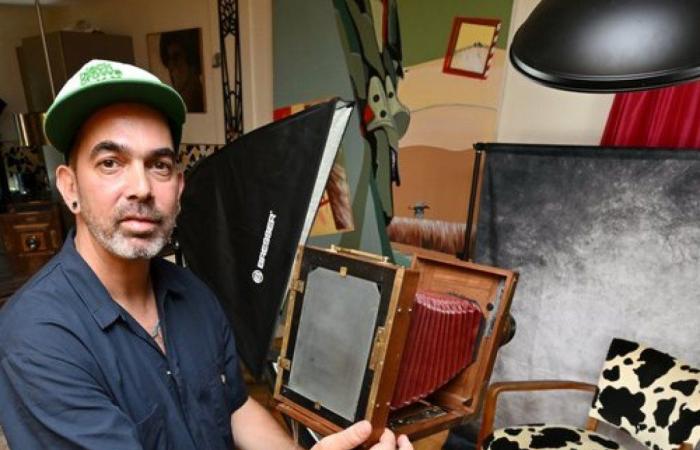the essential
Naitchez Martin is a photographer of a genre that is disappearing. He creates photos with a very old technique, that of wet collodion. He takes portraits with cameras dating from the middle of the 19th century, on iron or glass. With his mobile darkroom, he scours the festivals.
Put down your smartphone and travel back in time to 1860. At that time, negatives had not yet been invented. It takes a good half hour to take a portrait of someone. The technique used is wet collodion, powdered cotton dissolved in ether. Two exposure sessions are required, as well as two passes in the darkroom.
When the image finally appears in its bath on its iron plate (ferrotype) or glass plate (ambrotype), the result is astonishing. “There is an emotion in the looks that is inimitable,” explains Naitchez Martin. “I always have as much emotion seeing them appear.”
This photographer was passionate about this technique – the second commercialized after daguerreotypes, between 1850 and 1880 – which he discovered while looking into alternative processes. “I fell in love with it. A photo is made to capture the soul of the person and I sometimes feel like I’m succeeding,” he explains. “Something happens at the moment of posing, it’s a moment of sharing that has an impact on the rendering of the portrait.”
As you will have understood, for this kind of photo, you have to take your time. This is what Naichtez did, who calls it “low photography”, by patiently hunting down cameras, devices from the same era. Then he had to understand the process: “It’s complex to get to grips with, I had a lot of failures.” For a year and a half, he has mastered the technique, and takes photos in his studio, at home in Aussonne, or outdoors. He transports his darkroom, his projectors and his camera in his truck. He goes to people’s homes and is regularly invited to events, such as the “Faites de l’image” festival this summer in Rangueil, contemporary art gatherings or tattoo shows.
“These photos won’t move for 200 years”
“With the vintage trend, we feel a real interest from people,” he adds. “In addition, it is one of the best photo qualities available, it is linked to the size of the sensors and the fineness of the silver grains. If they are well preserved, these photos will not move for 200 years.”
DDM – FREDERIC CHARMEUX
The day we arrive, it is Maëva who poses for Naitchez. In the previous days, he has made his own chemicals: the famous collodion, the iron sulfate developer and the silver bath. He pours the liquid collodion onto the plate, then dips it in the silver bath in the darkroom for 3 minutes. He then takes his head out from under his black curtain to insert the plate into a wooden frame, which he slides into the camera.
During the shooting, Maëva must not move for several seconds. The focus has already been set on a frosted glass plate. The plate goes back to the darkroom, to be tested with iron sulfate developer. Naitchez pours the fixer, and Maëva’s face appears on the plate, in black and white. With her piercing gaze, fine skin texture, and a blur behind her, she looks like a Cheyenne princess from another time. Superb.







